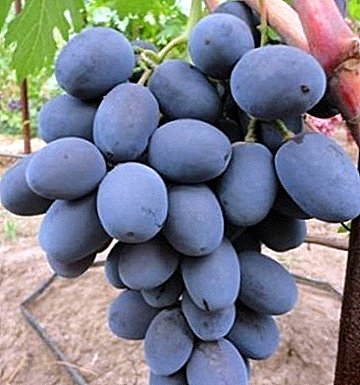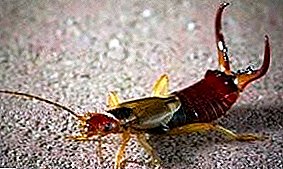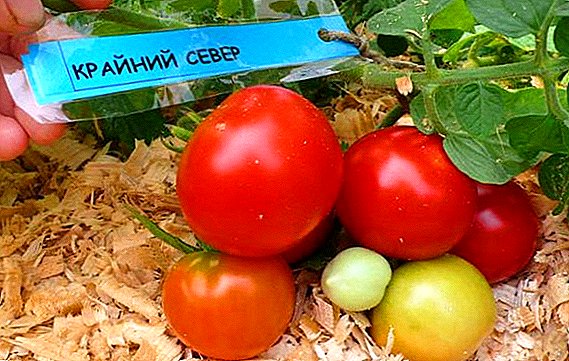
One of the brightest representatives of grape varieties that give early harvests is the "Buffet".
He gained his popularity due to a number of advantages, among which - high productivity, excellent taste, excellent storage and transportation.
What kind is it?
"Buffet" belongs to the common category of table grapes. These also include Karmakod, Korinka Russian and Ataman Pavlyuk.
Seasonal growth and development of the plant takes a relatively small and medium terms.
On the full cycle of ripening berries takes from 115 to 125 days.
Crop traditionally removed in the second half of August.
This very beautiful, with a matte skin on the berries, dark blue grapes is a hybrid. Refers to new species, so now still under observation and test checks in the vineyards.
The berries of the same color have the witches Fingers, Magarach and Miner.
Buffet grapes: variety description
The "Buffet" variety differs from other types by the following parameters:
- Bush. Usually grows very vigorously and reaches large sizes. Possessing excellent seed-forming ability, it thrives well, forming approximately 13-15 shoots per square meter.
- Vine. Characterized by excellent humility. Under normal agrotechnical conditions, it is quickly drawn out. The process of full maturation of the shoots of this variety is completed by the end of the vegetative period. Standard pruning is done on 5-8 eyes.
- Flower. Hermaphroditic type (oboepoly) with good pollinability.
- Berry. The size of the fruit on average varies from large to very large (maximum values - 28 x 36 mm).
Most often one berry weighs about 13-17 g, but there are cases when the weight of an individual fruit reaches 20 g. A standard fruit has the shape of a somewhat elongated oval or egg. On the stalk, as a rule, it is held fairly firmly. Berry differs firm, pleasantly crunchy when eating juicy pulp.
- The skin of the fetus. Usually, when eating grapes, it is felt very faintly or not at all.
During the ripening period, it has a blue and a dark blue color, which turns completely black on a fully ripe berry. It is usually covered with a waxy purine bloom in a dull gray tint.
- Bunch. Large, has the shape of a cylinder with a cone. Differs in average density. When ripe berries reaches weight from 0.5 to 0.8 kg, sometimes up to 1.5 kg.
Anyuta, Korolek and Asya can boast large clusters.
A photo
Photo grapes Buffet:





Breeding history
The "Buffet" grapes were created by the famous Ukrainian breeder-grower Vitaliy Zagorulko, the author of two dozen hybrid varieties.
The basis of selection was the crossing of two varieties - Gift Zaporozhye and Kuban. While working on the novelty, Zagorulko set the goal to embody her main principles in her - to produce hybrid varieties that should be different early ripening, to get beautiful, large berries with excellent commercial-taste qualities.
The hand of this breeder also belong to Ruth, Vodogray and Bazhen.
Specifications

Due to some of its qualities, this grape variety is good both for its own consumption from a fresh vineyard and for sale in the market. The second point is closely connected with the transportation of large quantities of grapes and storage issues.
It should be noted that this species has excellent varietal taste. A balanced taste of ripe mulberry and a tone of not completely dried raisins are harmoniously "woven into" a balanced flavor bouquet.
Velika, Ataman and Romeo also have excellent taste.
"Buffet" is grown not only in regions with a warm climate, but also in areas characterized by a temperate climate with rather cold winters. The variety is completely resistant to frost down to -23 ° C.
Senator, Alex and Svetlana demonstrate good frost resistance.
To determine the "Buffet" grapes as a commercially viable variety, in addition to its ability to ripen early, some other parameters are also important. So, according to statistics, it is distinguished by high yield, and crop overload is not excluded.
But in order to achieve good fees, it is necessary to observe a number of important conditions.
In the process of planting bushes between them should be kept a distance of at least 2.5-3 m from each other.
In addition, experienced experts recommend performing a fan bezshtambovuyu form, doing trimming 5-8 eyes. For the good development of the bush on it after all the manipulations should be no more than 30 shoots. The same shaping is demanded by Viva Hayk, Nina.
For the industrial cultivation of this variety it is also valuable that it retains its presentation and taste, while remaining not torn on the bushes.
After harvesting the berries can be stored for a long time before use. The high density of fruits, as well as the presence of a waxy layer on the skin, make it possible not to worry too much about their condition during transportation.
Long-term storage is able to transfer such varieties as Perfect Delight, Queen of Grapes and Novocherkassk Anniversary.
Diseases and pests
Observations of practitioners engaged in the cultivation of this variety, in general, do not notice any significant damage to gray rot and wasps.
At the same time, in relation to such dangerous fungal diseases as mildew and oidium, "Buffet" demonstrates 3-point resistance (on a 5-point scale). This means that no more than 25% of the crops are infected.

Mildew can be actively distributed practically everywhere where the grapes are cultivated, except for areas with a hot dry climate. If you do not take the necessary measures of protection, then spores mildew, attacking all the green parts of the plant, causing his death.
These measures involve, in particular, two sprays to prevent the disease. The first is produced on the eve of flowering with polycarbocin (40 g per 10 l of water), polychrome (40 g), arceride (30-40 g) or copper chloroxide (40 g). Repeated prophylactic spraying is performed after flowering.
Oidium affects almost all parts of the grape bush, especially rampant in extreme heat. The sad result of the "activity" of the fungus is the drying of the shoots, the falling of the leaves, the rotting of the berries.
A solution of colloidal sulfur (80 g per 10 l of water) helps to fight this disease. It sprayed the affected areas (spraying necessarily after each heavy rain).
Do not forget about such common grape diseases as anthracnose, bacteriosis, chlorosis, rubella and bacterial cancer. Preventive measures against them, too, will never be superfluous.
"Buffet" is especially good for fresh consumption. In this case, he shows all his best qualities. But to achieve this, it is necessary to constantly look after him.












